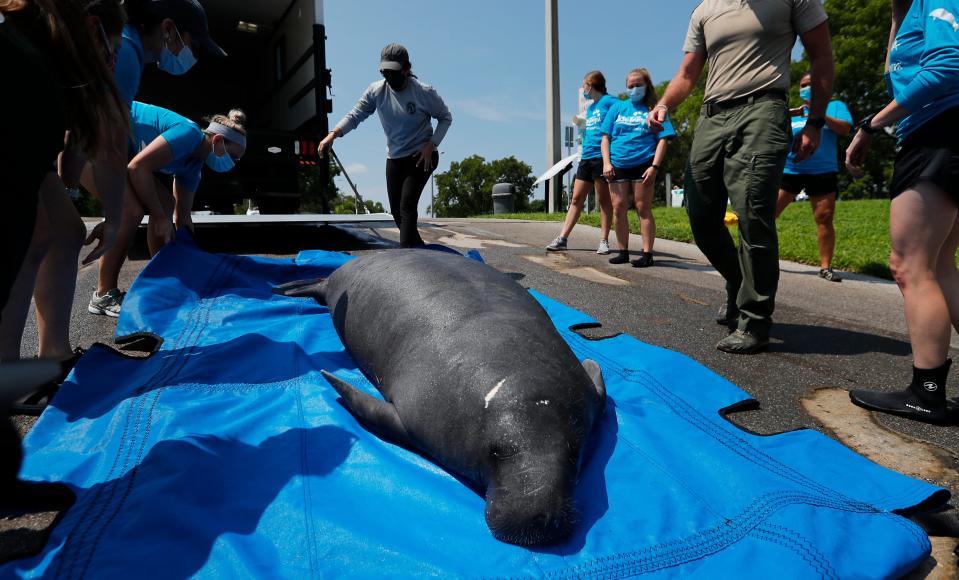As record Florida manatee deaths climb, state and feds prepare for another deadly winter
BREVARD COUNTY, Fla. — Wildlife management agencies are preparing for another potential round of mass manatee deaths they fear could occur as early as winter.
The Florida Fish and Wildlife Conservation Commission met in Bonita Springs Wednesday to talk about the Unusual Mortality Event, or UME, that has claimed hundreds of sea cows in the Indian River Lagoon.
"We're working to expand the facilities and we're doing that in case we have more mortalities this winter," said Larry Williams, a manatee biologist and expert for the U.S. Fish and Wildlife Service, the federal agency charged with protecting endangered and threatened animals. "There are a very high number of abandoned calves. So preparing for next winter, we're working with groups to expand and make sure they have the permits."
Florida has already broken the state record for the number of documented manatee deaths in a year, with the total quickly approaching 900.
Gil McRae, director of FWC's staff, said the problem is larger than the sea cow deaths.
"Ultimately it is not a manatee problem," McRae said. "It's more complicated than that. And we want to make sure commissioners understand the sense of urgency."
'How can we work together?': Starving manatees overwhelm Florida rescuers. Is there a future for the gentle marine giant?
Related story: 2021 is already the deadliest year on record for Florida manatees. Why are they dying?
With the manatee population nearing 8,900, some at the meeting said the overall manatee story should be positive and that the real story should focus on how well the animal has recovered in the past three decades.
Others said the focus should be on losing about 10% of the known population in less than a year.
Manatees live to be 50 to 60 years old, with females giving birth every two to five years. They live in waters from Texas to North Carolina, with the heart of the U.S. population being found in Florida.

Long-term threats include watercraft kills and habitat and food loss.
McRae said death rates have returned to more normal levels on the east coast, pointing out that the state has experienced a year's worth of manatee deaths in six months.
"We had manatee deaths along the entire Atlantic coast from lower St. Johns to southeast Florida," McRae said. "By May of 2021 the number of carcasses had returned to normal levels. But because of this big slug of manatees on the east coast, we've already set a record six months into the year."
Manatees are suffering this fate after being downlisted from endangered to threatened by the U.S. Fish and Wildlife Service in 2017.
Advocates say the downlisting should not have taken place and that this recent mortality event is proof of that.
Rare brain condition: 'Mom, my head hurts.' Then came a 7-hour emergency brain surgery.

McRae said the agency is trying to deal with a large number of calves that are often in poor health after losing their mothers.
"One thing that's unique to this particular event that we haven't seen before is a number of motherless calves," McRae said. "These calves require a great deal of care and they often have to be bottle fed and it can be two years until they're ready to be released from captivity."
And trying to manually feed hundreds of manatees is virtually impossible because it would require tons of food spread out over hundreds of miles on a daily basis.
"It's the first event due to starvation, and we've never had that before," McRae said. "Supplemental feeding or provisioning — we just had a workshop on it. They had really good discussion but we generally know that supplemental feeding does more harm than good, and manatees eat hundreds of pounds of food a day."
FWC Commissioner Michael Sole said the problem along the Atlantic coast with nutrient pollution and seagrass loss isn't just confined to the Indian River Lagoon.
"There has been the same, evil seagrass loss in the St. Lucie because of (Lake Okeechobee) releases and nutrients there," Sole said. "There's not a lot of refuge until you get south of the St. Lucie area."
The seagrass die-off is particularly problematic because restoring the habitat requires clean water, which is under the Florida Department of Environmental Protection, or DEP.
Most Florida water quality issues that have sprung up in recent years took decades to create, and many advocates and experts say it will take decades more to fix those problems.
The mortality story has become international in recent months as more and more manatees starve.
Kate McFall with the Humane Society of the United States said she's heard from manatee advocates across the country in the past nine months.
"These problems began many decades ago but I also see this as an opportunity for you to turn things around for manatees," McFall said. "It’s a complicated problem that took a long time to create but there are big steps to make going forward."
Without proper water clarity in the Indian River Lagoon and other ailing systems, restoring seagrasses can be pointless if the water is still clouded and polluted.
"In a healthy ecosystem you have clear water and sunlight can come through and seagrasses grow and manatees feed on them," McRae said. "Then you get too much nutrients and then an algae bloom. The seagrass gets shaded. It dies off and there's no more food and manatees are starving."
Sole said the agency needs to prepare for another round of deaths as manatees will return to the Indian River Lagoon again when the weather gets cooler later this year.
"We've got another winter ahead of us," he said.
Follow Chad Gillis on Twitter: @ChadEugene.
This article originally appeared on Fort Myers News-Press: Manatee deaths rise as wildlife agencies grapple with seagrass loss

 money
money 